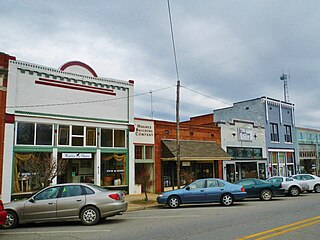
Montevallo is a city in Shelby County, Alabama, United States. A college town, it is the home of the University of Montevallo, a public liberal arts university with approximately 3,000 students. As of the 2020 census, the population of the city of Montevallo is 7,229.

The University of Montevallo is a public university in Montevallo, Alabama. Founded on October 12, 1896, the university is Alabama's only public liberal arts college and a member of the Council of Public Liberal Arts Colleges. The University of Montevallo Historic District was established in 1979 and included 16 buildings on campus. It was expanded in 1990 to include 75 buildings total. It is located in a rural location in central Alabama.

The Fulton Mansion State Historic Site is located in Fulton on the Texas Gulf Coast, in the county of Aransas, in the U.S. state of Texas. It is one of the earliest Second Empire style buildings constructed in Texas and is one of the most important of the style in the Southwest United States still in existence. Colonel George Ware Fulton and Harriet Gillette Smith began building the 4 story structure overlooking Aransas Bay in 1874 and finished in 1877. The residence, dubbed "Oakhurst" by its owners George & Harriet, featured the most up-to-date conveniences for the time, such as indoor plumbing reaching sinks in every bedroom, gas lighting and central heating, along with three bathrooms and two built-in copper tubs.
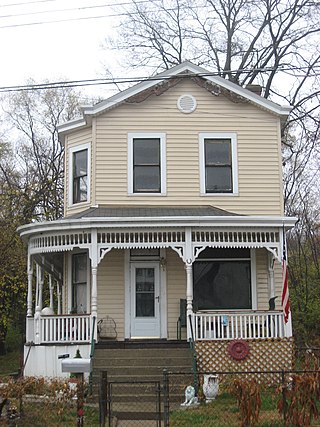
The LuNeack House is a historic residence in the Columbia-Tusculum neighborhood of Cincinnati, Ohio, United States. Built in 1894, it is a frame building with clapboard walls, two-and-a-half stories tall. The overall floor plan of the house is that of a rectangle, with the front and rear being the shorter sides, although the original shape has been modified by the extension of the rear and a hexagonal bay on the western side.
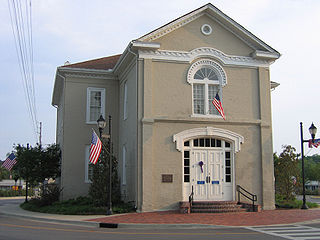
The Old Shelby County Courthouse, also known as Columbiana City Hall, is a defunct courthouse in Columbiana, Alabama. It was built in 1854. It served as the courthouse for Shelby County until 1906 when a larger court facility was built. It also served as Columbiana's city hall. Since 1982, it has housed the Shelby County Museum and Archives and its operator, the Shelby County Historical Society.

Herron–Morton Place is a historic district in Indianapolis, Indiana, United States. The boundaries of the neighborhood are East 16th Street on the south, East 22nd Street on the north, North Pennsylvania Street on the west, and Central Avenue on the east.
The Church Street East Historic District is a historic district in the city of Mobile, Alabama, United States. It was placed on the National Register of Historic Places on 16 December 1971. Since a boundary increase on 13 January 1984, it is roughly bounded by Broad, Conti, Water, Claiborne, and Canal Streets. 20 April 2005 saw the further addition of 66 & 68 Royal Street to the district. The district covers 1,403 acres (5.68 km2) and contains 83 contributing buildings and one object. It contains portions of Mobile's 19th century downtown area and features government, museum, commercial, and residential structures in a variety of 19th-century styles. The buildings range in age from the 1820s to 1900 and include the Federal, Greek Revival, Renaissance Revival, Italianate, and various other Victorian architectural styles. Notable buildings include the Government Street Presbyterian Church, Barton Academy, and the Ketchum House.
Winnona Park is a historic area in the southeast corner of the Atlanta, Georgia suburb of Decatur. It is listed as a historic district on the National Register of Historic Places, but it is not one of the City of Decatur's locally designated historic districts.
The Samuel R. Murphy House, also known as the Winfield Scott Bird House, is a historic structure in Eutaw, Alabama. The one-story Greek Revival house was built in the 1850s by Samuel R. Murphy, in part with materials salvaged from the old Mesopotamia Presbyterian Church. It was purchased by Winfield Scott Bird in 1869. The house was placed on the National Register of Historic Places as part of the Antebellum Homes in Eutaw Thematic Resource on April 2, 1982, due to its architectural significance.

The Robert Donnell House is a historic house located at 601 South Clinton Street in Athens, Alabama.

The Edmund King House is a historic residence on the campus of the University of Montevallo in Montevallo, Alabama. The house was built by Edmund King, a native Virginian who arrived in Alabama in 1817. First building a log cabin, he built the house in 1823. After becoming a successful planter and businessman, he donated land for churches, roads, and schools, including for the Alabama Girls Industrial School. Upon his death in 1863, the house passed to a son-in-law, and was deeded to the Industrial School in 1908. The house has been used as a classroom, an office building, an infirmary, a home economics practice home, and a summer home for male students. Today, the home is used as a guest house for visitors to the University.

The Manse is a historic house in Natchez, Mississippi. It has been listed on the National Register of Historic Places since March 7, 1979.

Court Street Historic Residential District is a national historic district located at Fulton, Callaway County, Missouri. It encompasses 84 contributing buildings in a predominantly residential section of Fulton. It developed between about 1844 and 1945, and includes representative examples of Queen Anne, Second Empire, Colonial Revival, American Foursquare, and Bungalow style architecture. Some of the buildings were designed by noted local architect Morris Frederick Bell. Located in the district is the separately listed Brandon-Bell-Collier House. Other notable buildings include the John W. Tucker Residence (1912), Klinginsmith Residence, Synodical College-Seminole Apartments, Synodical College Dormitory-Seminole Apartments (1913), Gish Residence, Dave and Ida McCue House, First Presbyterian Church, Leland Waters Residence, Bauer House, and Martin-Harris House.

The Bray-Barron House is a historic house in Eufaula, Alabama, U.S.. It was built prior to 1850 for Nathan Bray, who went on to serve in the Confederate States Army during the American Civil War of 1861-1865 alongside his three brothers. The house remained in the family until 1963. It was purchased by N. G. Barron and his wife Ruby Hutton Barron in 1965. It has been listed on the National Register of Historic Places since May 27, 1971.

The Rice-Semple-Haardt House is a historic house in Montgomery, Alabama, U.S..
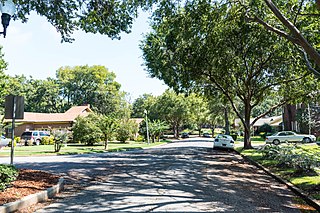
Arlington Park in Birmingham, Alabama, also known as Arlington-West End Historic District, is a historic district which was listed on the National Register of Historic Places in 1926. The listing included 68 contributing buildings on about 50 acres (20 ha). The contributing buildings were all built during 1920 to 1929.

The Downtown Montevallo Historic District in Montevallo, Alabama is a historic district which was listed on the National Register of Historic Places in 2013. It included 30 contributing buildings and four non-contributing buildings.

The University of Montevallo Historic District was added to the National Register of Historic Places in December 1978 and originally included 25 acres and 16 structures. These structures made up the core part of the campus and included residence halls, academic buildings, and water towers on campus. The original 16 structures were divided into four categories; Federal Revival style buildings, Greek Revival style buildings, buildings dating from 1897 to 1940, and buildings dating from the 1950s to 1977. In 1990, the Historic District was expanded to include 59 more structures directly surrounding the original Historic District, bringing the total number of structures in the district to 75. The structures added included additional campus buildings, domestic dwellings, a cemetery, and other contributing resources related to the University of Montevallo.
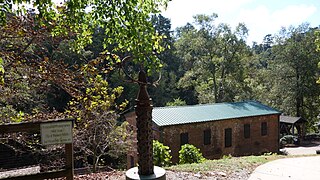
The Roswell Historic District, in Roswell, Georgia in Fulton County, was listed on the National Register of Historic Places in 1974.
















